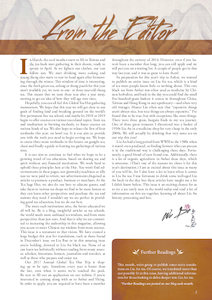
 |
|

In March, the cool weather starts to lift in Taiwan and the tea buds start gathering in their shoots, ready to sprout in April. As we lighten our clothes, our teas follow suit. We start drinking more oolong and young sheng also starts to rear its head again after fermenting through the winter. This window of time is interesting, since the fresh green tea, oolong or sheng puerh for this year aren't available yet, we turn to one- or three-year-old sheng tea. This means that we taste these teas after a year away, starting to get an idea of how they will age over time.
Hopefully, you can all feel this Global Tea Hut gathering momentum. We hope that this year we will get close to our goals of finding land and breaking ground on the world's first permanent free tea school, and maybe by 2018 or 2019 begin to offer courses on various tea-related topics, from tea and meditation to brewing methods, to linear courses on various kinds of tea. We also hope to release the first of four textbooks this year: on bowl tea. It is our aim to provide you with the tools you need to begin serving tea. We hope to create three more textbooks in the future: on gongfu tea, chaxi and finally a guide to hosting tea gatherings of various sizes.
It is our aim to continue to fuel what we hope to be a growing trend of tea education, based on sharing tea and spirit without any financial motivation. We work hard to uphold these principles here at the Hut. You won't find advertisements in these pages, nor gimmicky machines or silly teas we were paid to review, nor advertisements disguised as articles to promote a product, business or merchant. At the Tea Sage Hut, we also do our best to educate guests, and take them to various tea shops we find to be more honest so they can learn other perspectives and purchase the tea and teaware they need. I wouldn't say we are perfect in providing good tea education, but we do our best.
The more such institutions arise, the better educated we all will be. Be it a blog, insightful articles or tea schools, the world needs more unbiased tea wisdom, and from more perspectives than just ours. And that is why we are committed to increasing the authorship in this magazine, allowing you access to more Chinese tea wisdom from more sources. This issue is a testament to that vision. We have created a large budget this year for translations, such as those found in December's issue on Liu Bao or in this amazing issue you're holding, devoted to Liu An black tea. None of us can learn tea holistically without reading from many sources: scholars, historians, farmers, journalists and travelers, as well as those who prepare and enjoy tea.
Our 2017 Annual Global Tea Hut Trip is shaping up to be epic. Somehow, every year is better than the last, even when it seems we've reached the peak. Be sure to fill out an application on our website if you're interested in coming along with us to Anhui and Yixing. In order to apply, you are required to have been a member throughout the entirety of 2016. However, even if you haven't been a member that long, you can still apply and we will put you on a waiting list. A couple of people got in that way last year, and it was so great to have them!
In preparation for this year's trip to Anhui, we wanted to publish an entire issue on Liu An tea, which is a kind of tea most people know little to nothing about. This rare black tea from Anhui was often used as medicine by Chinese herbalists, and back in the day you could find the small five-hundred-gram baskets it comes in throughout China, Taiwan and Hong Kong in any apothecary - and often very old vintages. Master Lin often says that "expensive things aren't always nice, but nice things are always expensive." I've found that to be true, but with exceptions, like most things. There were three great, bargain finds in my tea journey. One of three great treasures I discovered was a basket of 1930s Liu An in a medicine shop for very cheap in the early 2000s. We will actually be drinking that very same tea on our trip this year!
Liu An had a long period from WWII to the 1980s when it wasn't even produced, so finding farmers who can process it in the traditional way is challenging these days. Fortunately, a good friend of ours found one. Additionally, there is a lot of organic agriculture in Anhui these days, which is awesome. (That's one of the reasons we chose it for this year's destination.) I am as excited about this issue as many of you will be, for I also have a lot to learn when it comes to Liu An tea. I was fortunate to drink some well-aged Liu An back in the day, but these articles have taught me a lot I didn't know before. This issue is an exciting chance for us to try a tea rarely seen in the world today and read a lot of information on this tea together, learning all about Liu An history, processing and lore.

This month, we're going to publish some extra translations on Liu An tea. Of course, we translated more than can possibly fit in this issue, leaving additional information for those looking to delve deeper into Liu An tea.